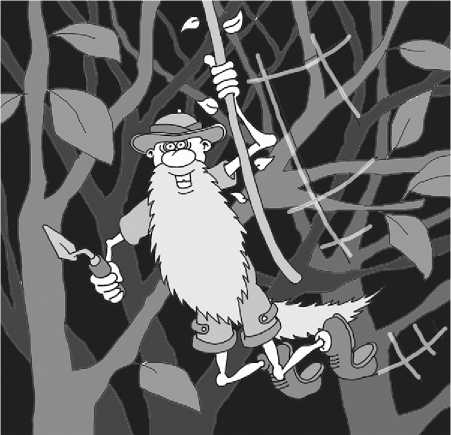According to Roslynn Haynes, scientific discovery is the greatest of all adventures, and the scientist as heroic adventurer is one of six recurring archetypes of scientists in Western literature. By the same token, the theme of adventure is the single most important association with archaeology throughout popular culture. Archaeology has come to stand for a quest involving travel to exotic locations, simple living and working conditions in the field, unexpected tests and

Figure 1
Drew.
The archaeologist as adventurer, cartoon by Quentin
Dangers, followed by spectacular discoveries, recovery of treasures, and the successful return home of the virtuous hero - all forming parts of essential adventure stories (Figure 1).
The associations of archaeology with adventure are as old as archaeology itself. In a famous passage written more than three decades before Indiana Jones, the American archaeologist Alfred Kidder argued that
In popular belief, and unfortunately to some extent in fact, there are two sorts of archaeologists, the hairy-chested and the hairy-chinned. [The hairy-chested variety appears] as a strong-jawed young man in a tropical helmet, pistol on hip, hacking his way through the jungle in search of lost cities and buried treasure. His boots, always highly polished, reach to his knees, presumably for protection against black mambas and other sorts of deadly serpents. The only concession he makes to the difficulties and dangers of his calling is to have his shirt enough unbuttoned to reveal the manliness of his bosom. (Alfred Kidder, 1949: XI)
The A theme has often been employed to tell the stories both of archaeologists’ research in the present and of the history of archaeology. In this view, the archaeologist is an uncompromising adventurer and explorer who conquers ancient sites and artifacts, and earns just rewards for pushing forward the frontiers of our knowledge about the past.
The three existing Indiana Jones movies (Raiders of the Lost Ark, 1981; Indiana Jones and the Temple of Doom, 1984; Indiana Jones and the Last Crusade, 1989) created by George Lucas and Steven Spielberg are quintessential action/adventure films. The archaeologist hero, a young University Professor, was played each time by Harrison Ford. Indiana’s clothes and Fearless character, the exciting storylines with many action scenes, and the exotic sets - all were carefully developed to suggest classic adventure in the tradition of King Solomon’s Mines (1950) and Secret of the Incas (1954). So much so that the poster to the second film proclaimed that ‘‘If adventure has a name, it must be Indiana Jones.'' All films were international successes, and led to the creation of a lot of merchandise as well as computer games, comic books, roleplaying sourcebooks, a TV series, and various kinds of novels for all age groups. The three films together grossed more than US$ 1 billion at the box office alone. When Indiana Jones once appeared in late December on the German TV channel ARD, they advertised that ‘‘Christmas has been saved.’’
Indiana Jones is the most widely recognized and most enduring image of an archaeologist. His incredible popularity may partly rely on the fact that ‘‘No one's got balls like Indiana Jones'' as an ad in Playboy claimed. In a recent ranking by Premiere Magazine (April 2004) - two decades after the height of the cinematic Indiana Jones fever - the character still made rank no. 7 among ‘The 100 Greatest Movie Characters of All Time’. Even Disney has embraced Indiana Jones. Since 1995, Disneyland’s ‘Adventure Land’ features a ride called Indiana Jones Adventure - Temple of the Forbidden Eye which has proved to be extremely popular. Another ride with reference to the no.1 movie archaeologist was created in Disneyland Paris as Indiana Jones et le temple du peril. The British holiday park Chessington World of Adventures features a broadly similar though less-advanced ride in its Forbidden Kingdom area. It carries the promising title Tomb Blaster.
Stereotypes associated with adventure inform very much the image of archaeologists in children's toys (e. g., Lego, Playmobil), comic series, contemporary advertising, literary fiction, films as well as widely read magazines like National Geographic Magazine, among other areas of popular culture (Table 1). In particular, the ‘colonial style' clothes in which archaeologists appear often reveal intended associations with heroic adventures. Unfortunately, these cliches and narratives are not always harmless entertainment but can have highly problematic undertones that smack of colonial and imperial attitudes. For example, in the movie March or Die (1977) Max von Sydow plays the archaeologist Francois Marneau who is trying to secure an ancient Moroccan treasure at all cost. He is quite ready to sacrifice human lives and peace with the Arab tribes for what he - misguid-edly - considers the greater good of archaeology. Similarly, the American TV game-show Legends of the Hidden Temple (Nickelodeon, 1993-1996) involved a race of the participating children teams through
Lara Croft
Rick Dangerous Professor Sydney Fox, historian in the Department of Ancient Studies Professor Indiana Jones
Indiana Pipps, Indiana Ding, Indiana Goof, Indiana Jctns, Arizona Goof, etc.
Will Rock Professor Robson
Professor Bernice Summerfield
Vash
Table 1 Adventurer-archaeologists of popular culture
The heroine of the computer game and Tomb Raider films The hero of a classic computer game The heroine of the TV-series Relic Hunter
The hero in novels by various authors and three films by George Lucas and Steven Spielberg Goofy’s cousin who appears in Disney’s Donald Duck stories under various names in different countries
The hero of a computer game The hunky professor in the soft-porn film series The Adventures of Justine (1995-1996)
The heroine of several novels by various authors, originally part of Doctor Who
Character in the TV series Star Trek
An elaborate obstacle course evoking ruins in the jungle, in order to retrieve an artifact from ‘Olmec’s Temple’. In order to succeed they needed to bribe several ‘native’ Temple Guards along the way.
As shown in a brilliant analysis by the Austrian writer and expert in German literature Christiane Zintzen, a particularly well-suited template for such archaeological narratives has been the life and career of Heinrich Schliemann (1822-1890). Like few others, he personified both to himself and to others the lonely hero on a long journey. Despite being an outsider, he knew ‘the truth’ - in this case about the historical reality of Homer’s Troy - early on but was ridiculed until he finally embarked on his quest alone and under great difficulties. In the end, however, Schliemann, like the archetypal hero, proved himself right by making great discoveries, becoming accepted as scholars, and celebrated as a national hero. Many have since then drawn inspiration and motivation from this truly mythical story, so that one may even speak of a ‘Schliemann Effect’.
Best-selling accounts of archaeological romances involving mystery, adventure, and hardship but concluding with the reward of treasure were pioneered by the author Kurt W. Marek (1915-1972) alias C. W. Ceram who published in 1949 his instant classic Gotter, Graber und Gelehrte (Gods, Graves, and Scholars). This book tells the story of the ‘great’ archaeological adventures and discovery processes in the eastern Mediterranean, Egypt, the Middle East, and central America by focusing on the archaeologist heroes themselves. Among them are the celebrities Heinrich Schliemann, Arthur Evans, Howard
Carter, and Leonard Woolley. The appeal of this subject was such that Gotter, Graber und Gelehrte has been translated into 30 languages and sold approximately 5 million copies worldwide. The success of Ceram’s writing lies in a mixture of facts and exciting story-telling where the readers suffer with their heroes until they eventually succeed.
The use of numerous historical details and the frequent allusions to archaeology continuously advancing our knowledge by deciphering more and more of the past became key elements of a new literary genre thus established: the archaologischer Tatsachenro-man, or fact-based archaeological novel. This genre was very successfully continued by Geoffrey Bibby, Rudolf Portner, Philipp Vandenberg, among others. In the same spirit, if to you ‘‘the idea of exploring the ancient tombs of pharaohs sends shivers down your spine and swells a yearning in your heart,’’ travel companies like Fodors advise you (on their web pages) to ‘‘just go.’’ They offer special archaeological ‘explorations’ to far-away places where ‘‘plenty of secrets still remain hidden for modern-day explorers to unearth.’’ For those who do not travel, there is still TV with its many archaeological documentaries. A summary on the Internet of the recent British series Great Excavations (Channel 4, 2000) could not have been written better by Ceram himself:
[The series tells] the story of the fascinating and often eccentric science of archaeology, from its beginnings in the 18th century to the present. It is a tale of chance finds and clever deduction, of private enterprise and national plunder, of romantic adventures and sheer cunning, of the hunt for mysterious ancient civilisations and the desire for invaluable objects.
These story elements are also reminiscent of the archaeological adventures of Lara Croft, archaeological action heroine that over the past decade acquired first computer game acclaim and then movie fame. To date she is the only video game character who made it onto the cover of fashion magazines and to have appeared in car commercials. Lara can be described as a blend of Indiana Jones, James Bond, and Pamela Anderson. She is portrayed as (the stereotype of) the perfect woman, combining girl power with male fantasies. Yet contrary to how it might seem at first, Lara Croft does arguably not break the rule that heroic adventurer archaeologists are male. Instead, she can be seen as a male protagonist in female masquerade, for her body is the only thing female about her. This is hardly surprising though, given that the genre of the adventure story demands stereotypically male characteristics for its heroes. On the other hand, it may be precisely these characteristics that make Lara the epitome of the empowered woman.
One aspect that is sometimes forgotten in archaeological hero-stories is their final element: the eventual downfall of the hero and his being cut down to size. Even the glory of Schliemann began to fade after his death, when questions were raised about the ownership of the artifacts he shipped out of their countries of origin. By the same token, Indiana Jones, in the Last Crusade, manages to get hold of the Holy Grail and save his father but in the end he cannot hold on to it and remains an ordinary mortal.
However far the A theme may stray from the realities of professional archaeology, it has at least in parts been created and promoted by archaeologists themselves. It is beyond question that Heinrich Schliemann fabricated his autobiography so that his own heroic role would stand out more clearly. Even nowadays, archaeologists often do not hesitate to use phrases and generally represent themselves in ways that immediately evoke the A theme. Numerous exhibitions and their catalogs appeal to visitors through the term ‘treasures’ in their titles. The Swedish archaeologist Gciran Burenhult, who wrote a series of TV programs and books about his archaeological adventures, is introduced on the dust jacket of one of the volumes with the words:
To be an archaeologist is precisely as exciting as it sounds - at least if one works like Gtiran Burenhult. If one is an explorer of foreign cultures, then and now, whether here or on the other site of the globe.
Archaeologists have for a long time, even amongst themselves, considered the rituals of fieldwork and the making of finds as the core of their discipline: archaeological fieldwork certainly can be an adventurous experience. Arguably, there is a bit of an adventurer and Indiana Jones in every archaeologist. Indeed, many archaeology students chose their subject out of fascination for figures like Indiana Jones. Unfortunately, this has as a consequence that gender issues are far from unimportant in the discipline.




 World History
World History









